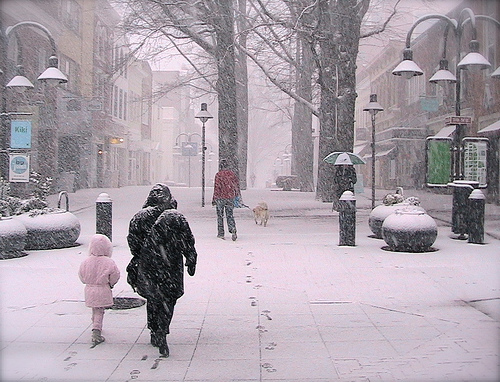 The political (or at least the Senatorial) tides are running strongly against a muscular policy response to climate change. Now a top NOAA scientist tells us that even the winds are blowing in the wrong direction — actual winds, mind you, not political. Via Science Daily:
The political (or at least the Senatorial) tides are running strongly against a muscular policy response to climate change. Now a top NOAA scientist tells us that even the winds are blowing in the wrong direction — actual winds, mind you, not political. Via Science Daily:
A warmer Arctic climate is influencing the air pressure at the North Pole and shifting wind patterns on our planet. We can expect more cold and snowy winters in Europe, eastern Asia and eastern North America.
Secure · Tax deductible · Takes 45 SecondsSecure · Tax deductible · Takes 45 Seconds“Cold and snowy winters will be the rule, rather than the exception,” says Dr. James Overland of the NOAA/Pacific Marine Environmental Laboratory in the United States. Dr. Overland is at the International Polar Year Oslo Science Conference (IPY-OSC) to chair a session on polar climate feedbacks, amplification and teleconnections, including impacts on mid-latitudes.
It’s not greenhouse gases per se that are driving these near-term changes — it’s the dramatic loss of sea ice along with warming-induced alterations to wind patterns, changes that Overland also referred to as “irreversible.” He explicitly linked this past year’s snowpocalypses to this Arctic warming, called “Arctic amplification” due to the fact that the Arctic is warming at twice the rate of the rest of the world. This is a significant finding for all sorts of reasons, but it also means climate change’s second order effects, i.e. the changes in the systems that the rise in greenhouse gases has affected, are now themselves causing real and meaningful climate alterations. And the pace will likely accelerate.
This news represents more than just the irony that extreme warming at the top of the world is resulting in snowier winters in the media and governmental capitals of the developed world. A paper from last year by Patrick Egan and Megan Mullin demonstrated that it’s not just our imagination: Public opinion on climate change does indeed move with the weather. For every three degrees of above average heat, there’s a 1 percent increase in a “belief” in climate change, especially among so-called “low information” voters. Sadly, the reverse is also true — above-average cold causes support to drop.
Climate skeptics will no doubt rejoice — and the rest of us will rue the fact — that any late-fall debate over climate legislation this year will likely involve senators making jokes about dodging snowplows on Pennsylvania Avenue.




